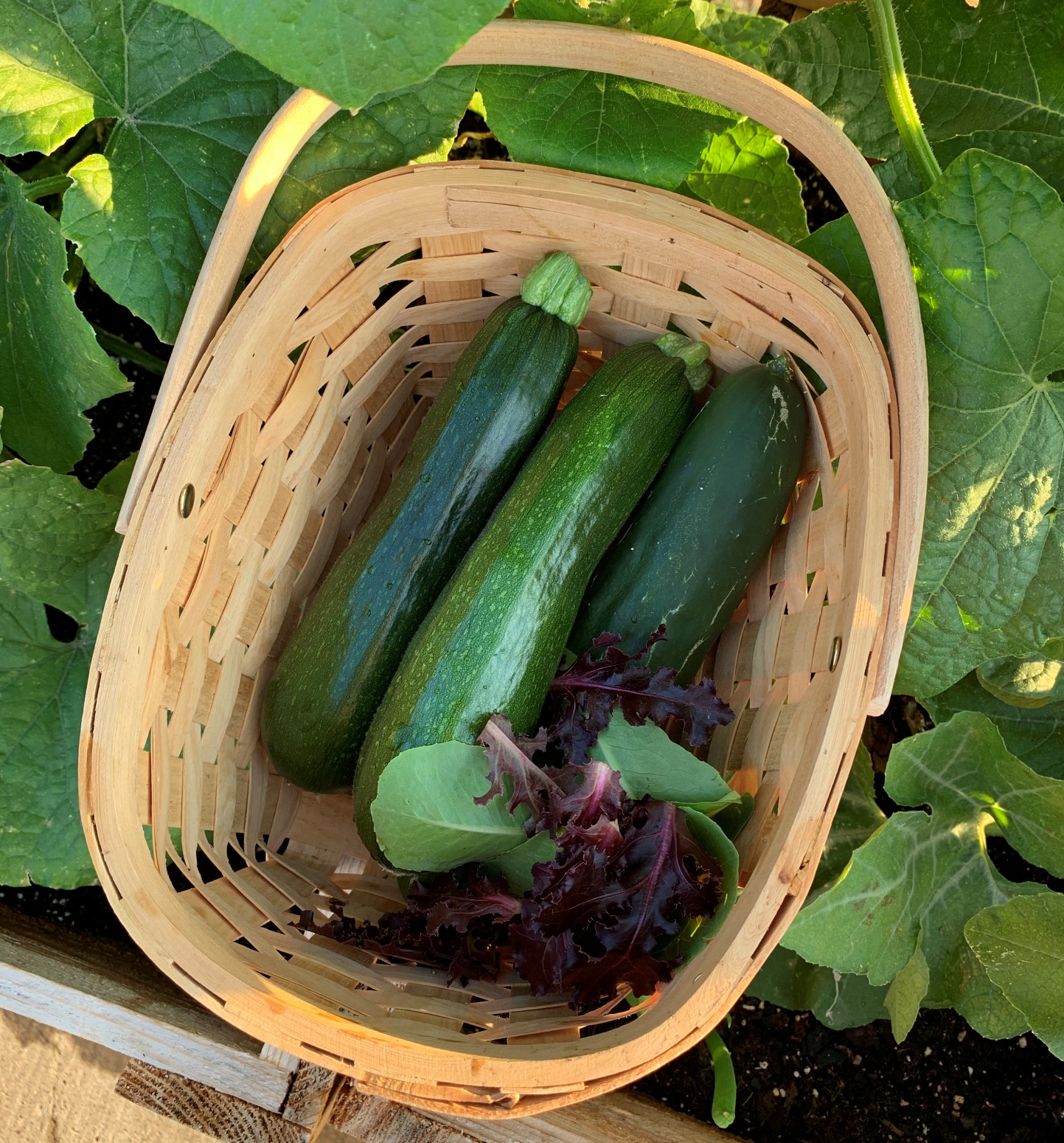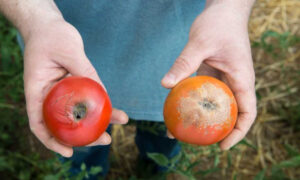Zucchini is a summer squash with an edible skin. It is believed to have originated in northern Italy. This amazing vegetable, low in calories and high in vitamin C, is a member of the cucurbit family, along with cucumbers, patty pan (scallop) squash, acorn squash, and melons. It’s known as marrow or courgette across the pond.
This article contains affiliate links. If you make a purchase using one of these links, I will receive a very small commission at no additional cost to you, and it will help me maintain this website. Rest assured, I only recommend products I actually like!
Planting Zucchini
You can successfully plant zucchini by either starting seeds under a grow light, directly sowing seeds into the soil, or by buying plant starts from nurseries and big box stores.
Plant starts, while somewhat reasonably priced, can add up quickly. To save money and to get a jump start on the growing season, plant seeds in a quality potting mix 4-6 weeks before your last spring frost date. They’ll be ready to harden off and transplant in containers outdoors once the threat of frost passes. Zucchini, like other summer squashes, do best in soil with a pH of 6.o to 7.0. You can learn more about soil pH in my article Soil pH and Why It’s Important.
If you prefer, you can directly sow seeds in containers outdoors two weeks after the chance of frost has passed. Sow a few seeds per container, cutting the weakest seedlings off at the soil about two weeks after they have sprouted. Do not pull them out or you may disturb or even uproot the preferred seedling. Whether planting indoors under a grow light or outside in the sun, be sure to keep the soil moist but not soggy, until the seedlings are established.
Container Size
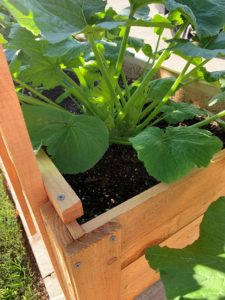
You may be surprised to find that even though zucchini are relatively large plants, you do not need to grow them in an enormous container to be successful. I’ve grown the Black Beauty variety in a clay pot measuring 15″ in diameter and 13″ inches deep (it actually had only 11″ of soil in it), and it did beautifully! I also raised a gorgeous one in a planter’s box that I made that measures 18″ x 36″ x 11″. There was even enough room to grow a trellised cucumber beside it! You can also use a food-grade bucket or something similar as long as there are holes for drainage. Regardless of what kind of container your choose, make sure the material it’s made of won’t leach into the soil (i.e., tires, cinder blocks, treated lumber, and unsafe plastics).
Sun and Water
Like other cucurbits, Zucchini plants need a minimum of six hours of full sun. The more sun, the better.
Zucchini plants are heavy drinkers, so be sure to provide them with enough hydration to keep them happy. Planting in containers will cause the soil to dry out quicker than if they were planted in the ground, so you’ll need to monitor the situation. When the soil feels dry a couple of inches below the surface, give it a thorough watering. Consistent, even moisture is the key.
Be sure to water the soil and not the leaves as a wet plant will attract powdery mildew which can eventually kill your plant and spread to the rest of your garden.
This article contains affiliate links. If you make a purchase using one of these links I will receive a very small commission at no additional cost to you, and it will help me maintain this website. Rest assured, I only recommend products I actually like!
Fertilizer
It’s easy to remember that plants need to drink, but we forget, they also need to eat! According to the Arizona Cooperative Extension’s website, fertilizing your container plants is a must:
Confined root systems demand frequent light fertilizing through-out the growing season. Nutrients are leached from the soil with every watering and need to be replenished.
I use a balanced fertilizer, (one that contains similar amounts of nitrogen, phosphorus,and potassium) about every seven to ten days.
Plant Varieties
Zucchini fruit, like the kind Black Beauty produces, are typically cylindrical in shape and dark green in color. This heirloom variety has compact vines and is ready to harvest in a mere 48 days.
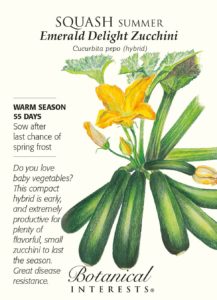
Caserta is another heirloom variety, but it produces a striped greenish-grey fruit with that can be harvested after 65 days. It, too, is a bush type that is suitable for containers.
If you’re looking for a variety that is resistant to powdery mildew and mosaic virus disease, you may want to try Emerald Delight. This compact hybrid variety produces smaller sized fruit and is ready to harvest in about 55 days.
Other cultivars, like the Cube of Butter, aptly named for its buttery flavor, are yellow in color. It’s also resistant to powdery mildew, which is always a bonus.
Not all zucchini are cylindrical, however. Some cultivars are spherical or even egg-shaped. Here’s a link if you’re interested in reading about other varieties suitable to growing in containers.
Pollination
Zucchini, like other cucurbits, require pollination. Male flowers on thin stems are the first to appear. They are more numerous than the female flowers, which arrive on the scene a few weeks later. You can easily distinguish a female flower from its counterpart because of the ovary, which is located under the blossom and looks like a miniature sized zucchini.
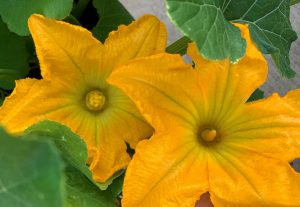
It’s helpful, although not necessary, to plant more than one zucchini plant as the additional blooms will better attract pollinators and pollinators mean more zucchini!
You may need to hand pollinate the blossoms if pollinators, such as bees, are scare. It’s quite easy and one way to make sure the job gets done. Take a cutip, or a very small soft-bristled paintbrush, and coat it with pollen located on the stamen of the male flower. Then simply transfer the pollen to the female flower’s stigma. Timing is important as male and female flowers are only open for about a day. The best time to hand pollinate is early in the morning when the flowers have newly opened. Each male flower has enough pollen for several female flowers. If the female is successfully pollinated, the ovary will begin to develop into a mature fruit.
Both male and female flowers are edible, but you’ll want to leave the female flowers on the plant since they are the ones that can mature into fruit. Simply remove the stamen from the male flower and eat it alone, in salads, or stuffed with cheese and deep fried.
Harvest
When to harvest will depend entirely on which variety you’ve planted. When the fruit reaches the proper size, cut it from the plant, making sure to leave a 1/2″ stem on the fruit. Do not try to break or twist the fruit off the plant as you will risk damaging both.
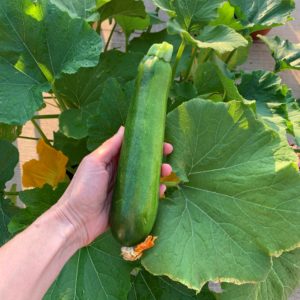
If a zucchini has grown past it’s optimum harvest size, no problem. It can still be cut into thin strips for a low carb “lasagna”, spiralized for a low carb “pasta,” or grated and used for zucchini bread or zucchini patties. You can even make a refreshing mocktail (alcohol-free drink) called Zucchini on the Rocks!
Pests
Zucchini is not only popular with humans, but insects love them, too. The ones to keep an eye out for are squash vine borers and squash bugs.
Borers are so named because the eggs of the vine borer moth when hatched, burrow into the stems of the plants where they begin to feed. The damaged stems prohibit water from adequately flowing through the plant, and the plant will eventually die. Here’s an article on how to identify, prevent and treat them organically.
Squash bugs, which are often confused with stink bugs and leaf-footed bugs, can also do quite a bit of damage to your plants by piercing them with their sharp proboscis (mouths) and sucking the juice out while injecting their toxic saliva.
Other insects like pickleworms, cucumber beetles, whiteflies and aphids also attack zucchini and other members of the cucurbit family.
Diseases
Powdery mildew is probably the most common disease cucurbit gardeners have to contend with. This prolific fungus causes white, fuzzy, or powdery-looking spots to appear on leaves and stems. It can severely damage the plant, but steps can be taken to both prevent as well as curtail the damage.
Zucchini and other garden favorites can also be affected by blossom end rot, which causes the bottom of the fruit to rot. It is caused by a calcium deficiency that occurs as a result of inconsistent watering.
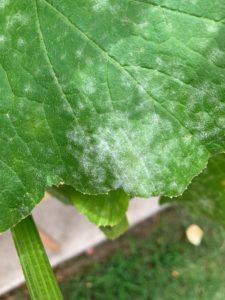
Bacterial wilt causes plants to wilt and die during the course of only one to two weeks. It is spread by insects, such as the cucumber beetle. Unfortunately, there is no cure for this disease, and infected plants will need to be pulled and thrown away.
Pruning Plants
The large zucchini leaves, while beautiful and lush, can take up a lot of space, and in the process, restrict airflow and sunlight to the inner areas of the plant. Increased airflow enables the plant to remain dryer, especially in more humid climates, thus decreasing the likelihood of diseases such as powdery mildew.
Select larger leaves and remove them by cutting the stems as close to the base of the plant as possible, taking care not to cut other areas of the plant. You’ll need to prune any dead leaves as well, again, to minimize the spread of disease. Do not prune more than 25% of the plant’s leaves.
Problem Solving
Lack of female flowers – see this article for insight.
Lack of fruit – if you have both male and female flowers, but there is little to no fruit development, it could be a lack of pollination. Try hand pollinating to increase fruit production.
Zucchini is such a fun and easy plant to grow, and it requires no gardening expertise! Plant it, and you’ll soon have enough to enjoy yourself and to share with others.
Note: If you found this article to be helpful, please share it with someone you think might be interested in it as well. Thank you!
